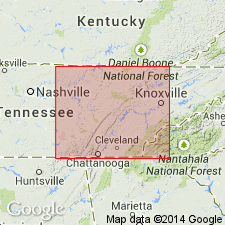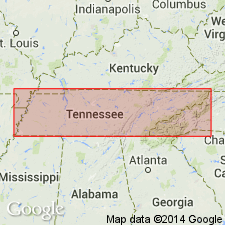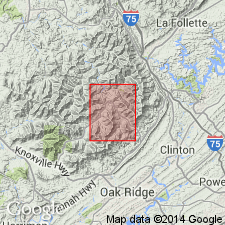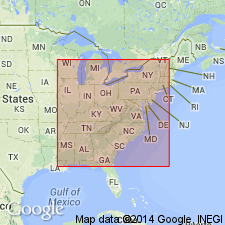
- Usage in publication:
-
- Vowell Mountain group
- Modifications:
-
- Original reference
- Dominant lithology:
-
- Sandstone
- Shale
- Coal
- AAPG geologic province:
-
- Appalachian basin
Summary:
Pg. 1, 11, 19, pls. 2, 3, 4, 6, 8. Vowell Mountain group. Includes all strata between top of Redoak Mountain group (new) below and base of Cross Mountain group (new) above that is between top of Pewee coal and top of Frozen Head sandstone. Thickness 230 to 390 feet. Includes (ascending) Split coal, Petree coal, Pilot Mountain sandstone, Lower Pine Bald coal, Upper Pine Bald coal, Rock Spring coal, and Frozen Head sandstone. Age is Early Pennsylvanian (Pottsville).
Type locality: Cross Mountain, Lake City quadrangle, Anderson Co., eastern TN. Named from Vowell Mountain, a spur on east side of Cross Mountain. Group is preserved only on higher mountains and, hence, has more restricted outcrop area than older groups.
Source: Publication; US geologic names lexicon (USGS Bull. 1200, p. 4093).

- Usage in publication:
-
- Vowell Mountain Formation
- Modifications:
-
- [Revised]
- Mapped
- AAPG geologic province:
-
- Appalachian basin
Summary:
(East-central and East sheets.) Vowell Mountain Formation. Shale, sandstone, siltstone, and coal; from Frozen Head Sandstone Member to Pewee coal. Thickness 230 to 375 feet in east-central Tennessee; 300 to 375 feet in eastern Tennessee. Lies below Cross Mountain Formation and above Redoak Mountain Formation. Age is Pennsylvanian.
[The Vowell Mountain Group of Wilson and others (1956) is reduced to formation rank. Its constituent formations, the Frozen Head and Pilot Mountain (not incl. on State geol. map), are also reduced in rank to members.]
Source: Publication.

- Usage in publication:
-
- Vowell Mountain Formation
- Modifications:
-
- Overview
- Dominant lithology:
-
- Sandstone
- Siltstone
- Shale
- Coal
- AAPG geologic province:
-
- Appalachian basin
Summary:
Consists of clayey to sandy, light-brown to dark-gray shale with coal beds and minor intercalated sandstone and siltstone; and yellowish-gray to yellowish-brown, fine- to medium-grained, thin-to thick-bedded sandstone, cross-bedded in part. Sandstones are mostly lenticular. Thickness is 240 to 400 ft. Age is Middle Pennsylvanian.
Source: GNU records (USGS DDS-6; Reston GNULEX).

- Usage in publication:
-
- Vowell Mountain Formation*
- Modifications:
-
- Revised
- AAPG geologic province:
-
- Appalachian basin
Summary:
Used as Vowell Mountain Formation in eastern TN. Includes all strata between top of Pewee coal and top of Frozen Head Sandstone Member. Also includes Pilot Mountain Sandstone Member. Lower part of Vowell Mountain includes part of strata previously assigned to Scott Formation or Shale (abandoned herein). Also includes strata previously assigned to Anderson or Bryson Formation (both abandoned herein).
Source: GNU records (USGS DDS-6; Reston GNULEX).
For more information, please contact Nancy Stamm, Geologic Names Committee Secretary.
Asterisk (*) indicates published by U.S. Geological Survey authors.
"No current usage" (†) implies that a name has been abandoned or has fallen into disuse. Former usage and, if known, replacement name given in parentheses ( ).
Slash (/) indicates name conflicts with nomenclatural guidelines (CSN, 1933; ACSN, 1961, 1970; NACSN, 1983, 2005, 2021). May be explained within brackets ([ ]).

